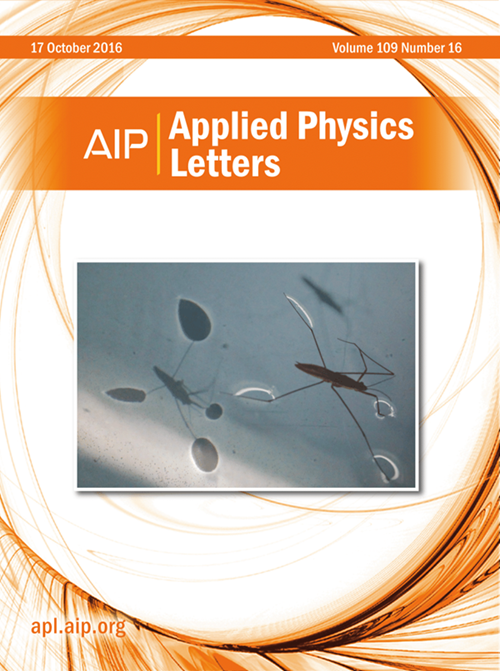InAs/InAsSb ii型超晶格的输运性质:从MWIR到VLWIR
IF 3.6
2区 物理与天体物理
Q2 PHYSICS, APPLIED
引用次数: 0
摘要
近年来,InAs/InAsSb ii型超晶格已成为中波长红外(MWIR)成像应用中与最先进的碲化汞镉系统相竞争的有希望的候选材料。然而,将它们的性能扩展到更长的波长仍然是一个挑战,因为载流子的输运特性往往会随着达到这种波长所需的超晶格周期的增加而降低。因此,详细研究作为截止波长函数的载流子输运性质的温度依赖性对于解决即将到来的挑战至关重要。在这项研究中,我们研究了大量的InAs/InAsSb型ii型超晶格样品的载流子输运性质,这些样品的截止波长从MWIR到甚长波红外(VLWIR)。对不同样品的少数载流子寿命的温度依赖性进行了研究和比较。我们还利用量子效率模型分析了空穴扩散长度和迁移率对温度的依赖关系。MWIR样品的迁移率(≈1.6 cm2/V s)比截止波长较长的样品低约一个数量级。此外,我们通过从暗电流密度模拟中提取少数输运性质来扩展我们的分析。我们的研究结果表明,随着截止波长的增加,迁移率增加,从MWIR样品的≈1.6 cm2/V s,到LWIR样品的≈27 cm2/V s,到VLWIR样品的≈200 cm2/V s。本文章由计算机程序翻译,如有差异,请以英文原文为准。
Transport properties in InAs/InAsSb type-II superlattices: From MWIR to VLWIR
In recent years, InAs/InAsSb type-II superlattices have emerged as promising candidates to rival state-of-the-art mercury cadmium telluride systems for mid-wavelength infrared (MWIR) imaging applications. However, extending their performance to longer wavelengths remains a challenge, as the carrier transport properties tend to degrade with the increasing superlattices period required to achieve such wavelengths. Consequently, a detailed investigation of the temperature dependence of carrier transport properties as a function of cutoff wavelength is critical for addressing the forthcoming challenges. In this study, we investigated the carrier transport properties of a large set of InAs/InAsSb type-II superlattices samples, with cutoff wavelength spanning from MWIR to very-long wave infrared (VLWIR). The temperature dependence of the minority carrier lifetime was examined and compared across samples. We also analyzed the temperature dependence of hole diffusion length and mobility using a quantum efficiency model. The mobility of the MWIR samples (≈ 1.6 cm2/V s) was approximately one order of magnitude lower than that of the samples with longer cutoff wavelengths. Further, we extended our analysis by extracting minority transport properties from simulations of dark current density. Our results show that mobility increases with cutoff wavelength, ranging from ≈1.6 cm2/V s for MWIR samples, to ≈ 27 cm2/V s for LWIR, and up to ≈ 200 cm2/V s for VLWIR.
求助全文
通过发布文献求助,成功后即可免费获取论文全文。
去求助
来源期刊

Applied Physics Letters
物理-物理:应用
CiteScore
6.40
自引率
10.00%
发文量
1821
审稿时长
1.6 months
期刊介绍:
Applied Physics Letters (APL) features concise, up-to-date reports on significant new findings in applied physics. Emphasizing rapid dissemination of key data and new physical insights, APL offers prompt publication of new experimental and theoretical papers reporting applications of physics phenomena to all branches of science, engineering, and modern technology.
In addition to regular articles, the journal also publishes invited Fast Track, Perspectives, and in-depth Editorials which report on cutting-edge areas in applied physics.
APL Perspectives are forward-looking invited letters which highlight recent developments or discoveries. Emphasis is placed on very recent developments, potentially disruptive technologies, open questions and possible solutions. They also include a mini-roadmap detailing where the community should direct efforts in order for the phenomena to be viable for application and the challenges associated with meeting that performance threshold. Perspectives are characterized by personal viewpoints and opinions of recognized experts in the field.
Fast Track articles are invited original research articles that report results that are particularly novel and important or provide a significant advancement in an emerging field. Because of the urgency and scientific importance of the work, the peer review process is accelerated. If, during the review process, it becomes apparent that the paper does not meet the Fast Track criterion, it is returned to a normal track.
 求助内容:
求助内容: 应助结果提醒方式:
应助结果提醒方式:


